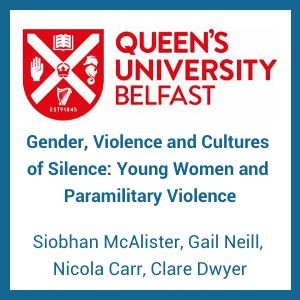Gender, violence and cultures of silence: young women and paramilitary violence
Siobhan McAlister, Gail Neill, Nicola Carr and Clare Dwyer

This is an insightful report looking at young women and their experiences of one specific form of conflict-related violence – paramilitary violence.
Despite a growth in analysis of women and conflict, this has tended to overlook the specific experiences of young women. Likewise, in research on youth, conflict and peace, the term ‘youth’ is often short-hand for young men. Young women’s experiences are regularly absent from research and policy discourse, and as a consequence, also absent from public understanding and practice responses.
This paper demonstrates that forefronting young women’s experiences, and adopting an understanding of violence beyond that which privileges physical violence, unearths the multiple ways in which conflict-related violence is experienced.
It further demonstrates how adopting an intersectional lens that priortises age and gender can surface the specific experiences of young women, and the various ways in which these become silenced by cultures that omit, coerce, reduce and minimise.
Please click on the link below to download the report.
